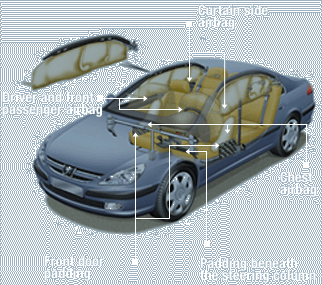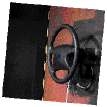

The picture above shows that there are now a huge variety of airbags available for all areas of the car and not just the traditional steering wheel airbag as we are accustomed to seeing.
Airbags were patented in the 1950s and were designed to be inflated with gas from a pressurized canister. These original airbags failed to catch on, however, because they were notoriously unreliable owing to the variable pressure of the gas inside.
Modern airbags are inflated by nitrogen gas, this is generated by exploding a charge of sodium azide. By careful control of the amount of sodium azide used, the exact amount of gas can be instantly released.


The general sequence of events which trigger the deployment of an airbag:
Collision occurs with another car or object.
If impact speed is above the 10 mph a sensor is activated which 'decides' whether to activate the airbag.
If deployment is necessary, the initiator (known as the squib) is activated which then detonates the main sodium azide charge.
A large volume of gas is produced, so filling the nylon airbag and providing protection for the driver of the car.
The whole procedure takes less than 25 thousandths of a second ( five times faster than the blink of an eye) and within another few thousandths of a second the driver hits the airbag which then immediately deflates to prevent suffocation.